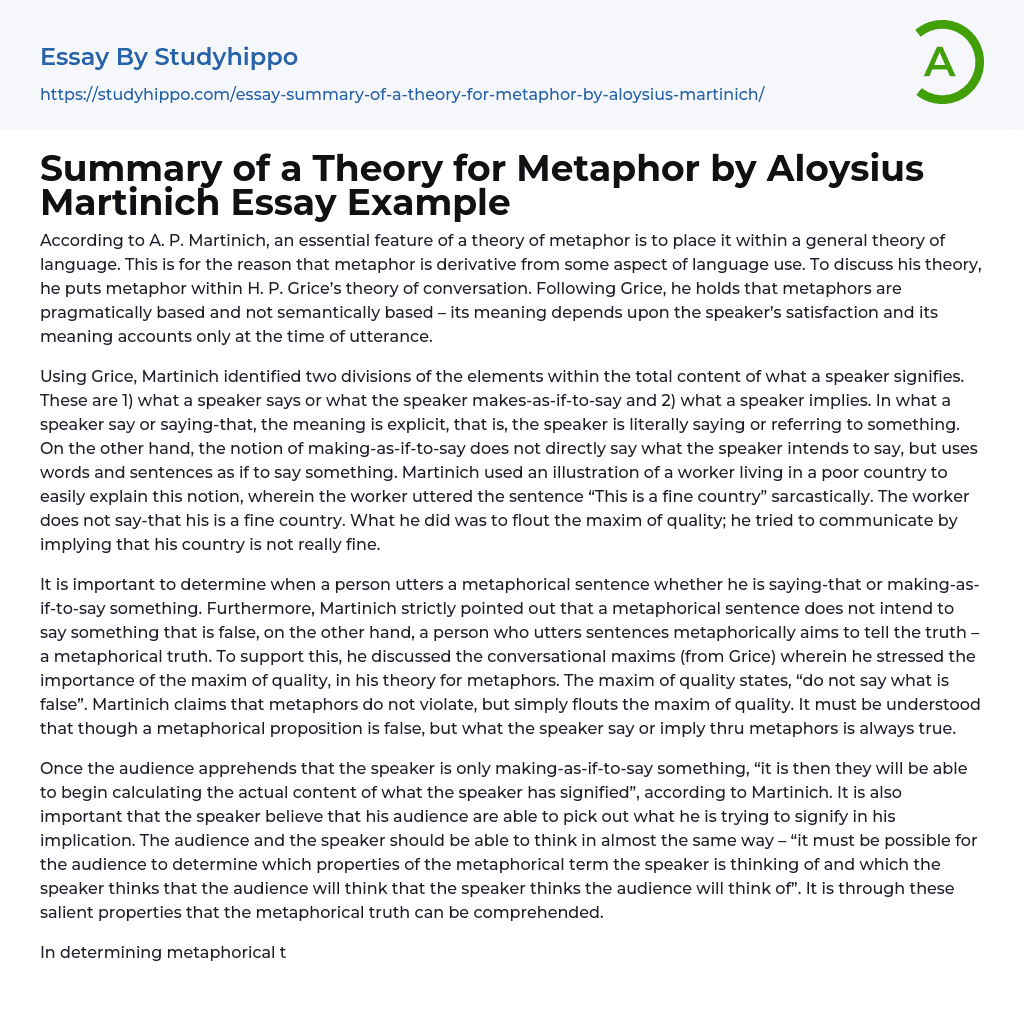

Summary of a Theory for Metaphor by Aloysius Martinich Essay Example
According to A. P. Martinich, an essential feature of a theory of metaphor is to place it within a general theory of language. This is for the reason that metaphor is derivative from some aspect of language use. To discuss his theory, he puts metaphor within H. P. Grice’s theory of conversation. Following Grice, he holds that metaphors are pragmatically based and not semantically based – its meaning depends upon the speaker’s satisfaction and its meaning accounts only at the time of utterance.
Using Grice, Martinich identified two divisions of the elements within the total content of what a speaker signifies. These are 1) what a speaker says or what the speaker makes-as-if-to-say and 2) what a speaker implies. In what a speaker say or saying-that, the meaning is explicit, that is, the sp
...eaker is literally saying or referring to something. On the other hand, the notion of making-as-if-to-say does not directly say what the speaker intends to say, but uses words and sentences as if to say something. Martinich used an illustration of a worker living in a poor country to easily explain this notion, wherein the worker uttered the sentence “This is a fine country” sarcastically. The worker does not say-that his is a fine country. What he did was to flout the maxim of quality; he tried to communicate by implying that his country is not really fine.
It is important to determine when a person utters a metaphorical sentence whether he is saying-that or making-as-if-to-say something. Furthermore, Martinich strictly pointed out that a metaphorical sentence does not intend to say something that is false, on the othe
hand, a person who utters sentences metaphorically aims to tell the truth – a metaphorical truth. To support this, he discussed the conversational maxims (from Grice) wherein he stressed the importance of the maxim of quality, in his theory for metaphors. The maxim of quality states, “do not say what is false”. Martinich claims that metaphors do not violate, but simply flouts the maxim of quality. It must be understood that though a metaphorical proposition is false, but what the speaker say or imply thru metaphors is always true.
Once the audience apprehends that the speaker is only making-as-if-to-say something, “it is then they will be able to begin calculating the actual content of what the speaker has signified”, according to Martinich. It is also important that the speaker believe that his audience are able to pick out what he is trying to signify in his implication. The audience and the speaker should be able to think in almost the same way – “it must be possible for the audience to determine which properties of the metaphorical term the speaker is thinking of and which the speaker thinks that the audience will think that the speaker thinks the audience will think of”. It is through these salient properties that the metaphorical truth can be comprehended.
In determining metaphorical truth, it is important to note that the context of the metaphorical utterance and the properties intended are only those that contribute to a true conclusion, that is, what the speaker intends to tell. A metaphor should be placed within a pragmatic theory, since its meaning depends on the context of its use.
Commentary:
style="text-align: justify">To arrive at the metaphorical truth, it is also important to know what factors made the speaker say what he is making as if to say. One factor can be his emotional state when he uttered the metaphor. For example, in uttering the statement “My love is like a red rose”, the meaning, or what the speaker is trying to imply, could differ depending on the speakers own situation. If he feels he is irrevocably happy with his love, then the statement accounts for the positive implications of the metaphor. If, for the moment, he feels frustrated or unhappy, the meaning would account for the negative, for example, that his love is difficult to handle, etc.
- American Literature essays
- Between The World and Me essays
- Book Report essays
- Book Review essays
- Book Summary essays
- Books essays
- Character essays
- Coming of Age essays
- Dante's Inferno essays
- Everyday Use essays
- Flowers for Algernon essays
- Genre essays
- Greek Mythology essays
- Incidents in The Life of a Slave Girl essays
- Letter essays
- Literary Criticism essays
- Literary devices essays
- Literature Review essays
- Metaphor essays
- Myth essays
- Play essays
- Plot essays
- Poem essays
- Poetry Analysis essays
- Protagonist essays
- Reader essays
- Reason essays
- Rhetoric essays
- Rhetorical Question essays
- Rhyme essays
- Simile essays
- Tragic Hero essays
- Translation essays
- Understanding essays
- Utopia essays
- Villain essays
- Writer essays
- Filipino Language essays
- Phonology essays
- Pragmatics essays
- Sentence essays
- Dialect essays
- English Language essays
- Second Language essays
- Semiotics essays
- Sign Language essays
- Spanish Language essays
- Experiment essays
- Explorer essays
- Hypothesis essays


Unfortunately copying the content is not possible
Tell us your email address and we’ll send this sample there.
By continuing, you agree to our Terms and Conditions.

